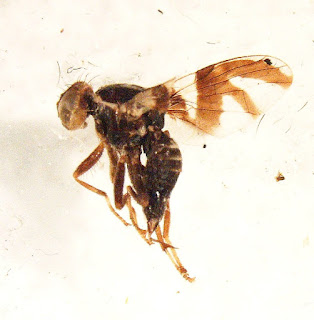Karla Salp
Communications
Each year, WSDA’s Pest Program sets thousands of traps
throughout the state to catch invasive species that could threaten agriculture.
The program surveys for over 130 pests – most of which have not yet been
detected in the state.
Japanese beetles
 |
| Dozens of Japanese beetles collected from a single trap |
It was a record year for Japanese beetle (Popillia japonica) catches - unwelcome news to farmers and homeowners alike. There was one catch in Washington across the river from Portland, a few as usual near Seattle-Tacoma International Airport, but more than 24,000 in the Grandview area. Catching so many in Grandview this year was surprising considering that only three were caught in 2020 between Grandview and Sunnyside combined.
 |
| Japanese beetles devour a Grandview resident's roses |
Japanese beetles attack over 300 different types of plants
including roses, hops, grapes, corn, lawns, and many other crops grown in area
gardens and farms.
If there is a silver lining to this beetle infestation, it
is that the city, businesses, schools, and people in the vicinity have been
open and willing to do what they can to help with WSDA’s response to this
invasive pest. Another positive: although nearly 100 traps were placed around area
plant nurseries, no beetles were found at the nurseries.
Invasive moths
 |
| Male Lymantria dispar |
This year was a low year for Lymantria dispar catches – only six were found in the entire state. Unfortunately, one of those moths was caught in Eastern Washington just north of Kettle Falls - which is unusual in itself as most moths are normally trapped in Western Washington – and it was also a more concerning variety – Lymantria dispar asiatica, formerly known as the Asian gypsy moth. Lymantria dispar asiatica eats a wider variety of trees (including evergreens) and the females can fly, allowing them to spread more easily.
Apple maggot
 |
| Apple maggot fly |
The good news this year is that many of our main
apple-growing regions had no catches at all this year: Adams, Asotin, Benton,
Douglas, Franklin, Grant, Lincoln, and Stevens counties. Less encouraging was
catching 120 apple maggots in Kittitas County and 843 in Okanogan County.
In areas where apple maggots have been detected outside of
the apple maggot quarantine area, the county pest boards are responsible for
taking aggressive action. WSDA and the Apple Maggot Working Group (an advisory
council composed of state and local government, industry representatives, and
researchers) began working last year to examine how best to address the growing
apple maggot problem in the unquarantined area of Okanogan County. That effort
will continue over the coming months.
Asian giant hornet
 |
| Asian giant hornet queen from the third nest with part of her nest |
Public trapping and reporting again played a major role in
locating the nests – two of the three were located after reports from area residents.
Despite existing research indicating that the hornets predominately nest in the
ground in their native range, all four nests eradicated in Washington over the
last two years have been in tree cavities.
Our hornet program will continue for at least three more
years. In order for the hornets to be considered eradicated, we must have three
consecutive years with no detections. The biggest challenge to success is the
lack of a highly-effective trap. While the traps we use catch hornets, they do
not appear to be irresistible to them. USDA continues to work on a lure that
will be more attractive to the hornets and we wish them much success!
Exotic wood-boring
insects
 |
| Velvet longhorn beetle |
This year, WSDA put out over 400 exotic wood-boring insect
traps at high-risk sites such as ports, shipping distribution sites, and transfer
stations. Trapped areas and other high-risk areas are visually surveyed for
signs of wood boring insect activity. One day, they found one.
“This is the first time in all of these years I have trapped
a target species,” Don Kitchen, one of the members of the beetle survey team,
said.
This past summer, the velvet longhorn beetle (Trichoferus campestris) was detected for
the first time in the state in King County near Kent. WSDA responded by setting more
traps and conducting visual surveys of the area, although no additional beetles
were found. WSDA will continue to put out additional traps, conduct visual
surveys of the area, and conduct outreach about the beetle in 2022.
The work continues
WSDA’s Pest Program has had a busy year – and this roundup
covers just a handful of the pests they monitor. With their continued work and
the help of the public looking for and reporting suspected invasive species,
our state should be protected from harmful pests for years to come.
